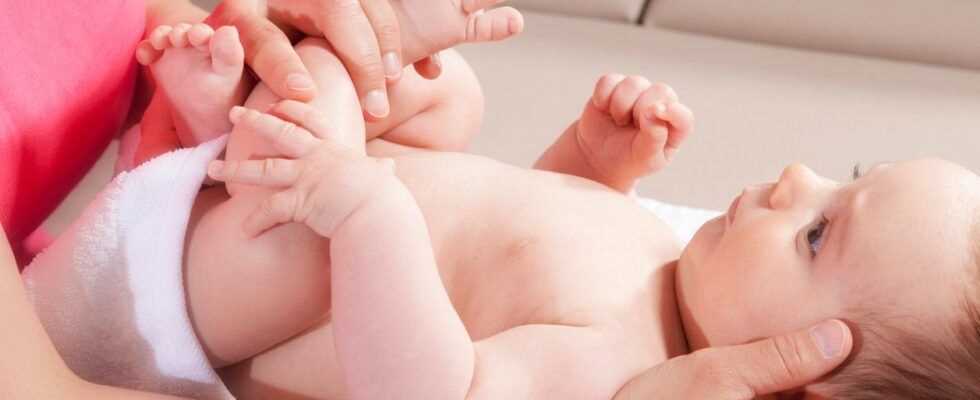KiSS syndrome is characterized by a disturbance in symmetry caused by the cervical vertebrae. It causes loss of mobility in babies which can affect their development. Explanations from the KiSS Paris Consultation Center.
KiSS syndrome comes from the German “Kopfgelenk Induziert Symetrie Störungen” which in French means “Symmetry Disorders Induced by the Cervical Vertebrates”. It was first highlighted in the 1980s by Dr. Heiner Bierdermann, surgeon, manual therapist.
It is an asymmetry induced by a dysfunction of the cranio-cervical junction, that is to say the articulation between the base of the skull and the first cervical vertebra.
What are the symptoms of KiSS syndrome?
In KiSS syndrome, the symmetry disturbances arise from the upper cervical spine. However, this plays an important role in the postural balance of the child. “It conditions the positioning of the head, which influences the sense organs (eyes, nose, ears, mouth …) and consequently on the balance of the rest of the body in relation to its environment ", explains the therapists of the KiSS Paris Consulation Center. When the postural balance is disturbed, it can cause many functional disorders in infants such as restlessness, vegetative disorders (frequent crying, sleep disturbances, reflux, colic), flattening of the skull, hypersensitivity of the neck and a motor development disorder. They usually appear in the first months of the baby's life and can in particular interfere with the proper course of breastfeeding because latching is difficult.
In addition to these symptoms, there may be other disorders specific to KiSS syndrome type I or II.
The characteristic signs of type I KiSS syndrome are:
- a tilt of the neck with reduced mobility of the head to one side.
- a smaller half of the face.
- a position in C of the body
- weaker motor skills on one side.
- deformity in the feet.
- weaker muscle tone on one side.
The characteristic signs of KiSS type II syndrome are:
- a refusal by the child to lie on his stomach.
- difficulty supporting his head.
- drooling and frequent vomiting.
- colic.
- shoulders raised.
- a lack of muscle tone.
- the head in hyper-extension.
Note that the blockage and tensions characteristic of KiSS syndrome vary from child to child. “In fact, it is common for children to have a combination of KiSS type I and type II symptoms", Reports the team at the KiSS Paris Consultation Center.
What are the possible causes of KiSS syndrome?
The lesion of the upper cervical spine responsible for KiSS syndrome is linked to a mechanism having abused the neck of the infant before or after birth. It can be a accident during pregnancy, improper intrauterine position, very short or very long childbirth, use of instruments during childbirth, induced childbirth, multiple pregnancy, premature rupture of the water bag or trauma on the head during the child's first months of life.
How to treat KiSS syndrome?
KiSS children are looked after by osteopaths “jUsing a full course in osteopathy and having a precise knowledge of the diagnosis and treatment of this syndrome not taught today in French osteopathy schools ". The osteopath can intervene after a doctor has requested an X-ray of the cervical spine to rule out any other pathology requiring medical treatment and for which structural manipulation is contraindicated.
This syndrome should not be confused with other problems which have common symptoms such as:
- Klippel-Feil syndrome (congenital malformation linked to a fusion of the cervical vertebrae, visible on an X-ray).
- congenital muscular torticollis (from birth, the head tilts to one side while the chin is turned to the opposite side).
- Sandifer syndrome (hiatus hernia and / or gastroesophageal reflux disease associated with abnormal posture of the child's head with involuntary muscle contractions).
Today, osteopathic treatment for KiSS syndrome can only start if the osteopath is in possession of a medical certificate of no contraindication to the manipulation.
Three osteopathy sessions are necessary for the treatment which requires specific knowledge of the syndrome, a precise diagnosis and a particular technical skill. At the KiSS Paris Consultation Center, sessions are done with four hands (two osteopaths). “We also systematically check for the presence of any food intolerances, as well as the brakes in the oral sphere (tongue frenulum, lip frenulum, etc.), which if they are restrictive, must be taken care of concomitantly”.
Support as soon as possible
The earlier the treatment, the less risk there is of accumulation of secondary adaptations. Indeed, a KiSS child who is not taken care of quickly will develop around this dysfunction of the cranio-cervical joint and after the age of 2 years, we will speak of KIDD syndrome. The child may have acquisition and developmental problems such as postural disorders, delayed maintenance of a sitting position, fine motor disorders, headaches and / or migraines, delayed exercise. learning to walk, the development of scoliosis, social problems or even chronic and unexplained discomfort.
Untreated KiSS syndrome can also have repercussions in adulthood by causing chronic back pain, neck pain, and balance disturbances (dizziness).
“This list of symptoms is neither exhaustive nor systematic. Each individual has a unique reaction and adaptation mechanism”, Concludes the team at the KiSS Paris Consulation Center.
Sources:
Read also on aufeminin
Baby's fontanelles in 5 questions
What is free motor skills?
Massage baby for a moment of shared happiness
